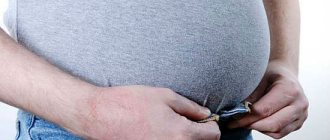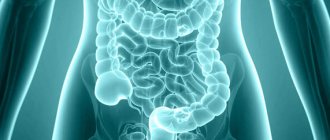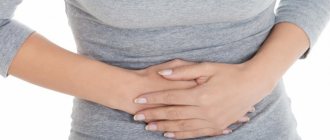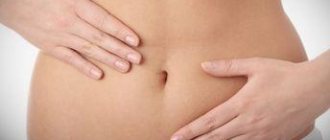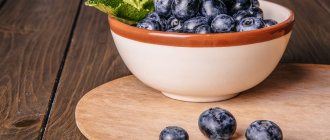Increased gas production, bloating, and the inability to empty the bowels on your own are the consequences of a disruption in the functioning of the gastrointestinal tract. Many people periodically face similar problems. Flatulence and constipation can be provoked by an abundance of flour products in the diet, junk food, and overeating. If after a few days digestion and stool return to normal, then there is no reason to worry. But when difficulties with bowel movements occur regularly, it is necessary to take special measures to restore stable functioning of the gastrointestinal tract.
Causes
Constipation and bloating may be associated with disruptions to your usual diet. Eating mechanically gentle, high-calorie foods, lack of fiber, and eating foods with an astringent and fixing effect are the main causes of unpleasant symptoms of intestinal dysfunction.
The list of such products includes strong tea, coffee, cottage cheese, boiled rice, pears, pomegranate, pomegranate juice, quince, flour, chocolate.
There are also less common groups of causes of stool retention combined with bloating:
- lifestyle features: lack of exercise, forced bed rest, sedentary work;
- endocrine and metabolic disorders;
- neurological factors;
- psychogenic causes;
- gastroenterological diseases;
- proctological diseases.
Shulpekova and Ivashkin indicate in their work that “among the causes of chronic constipation in the age group under 20 years, the anatomical features of the colon dominate; at the age of 20–40 years - pathology of the anorectal zone; after 40 years, psychogenic, neurogenic, endocrine, gastroenterological causes of constipation and causes associated with pathology of the anorectal zone are equally common” (Shulpekova Yu. O., Ivashkin V. T., 2004, p. 49).
Among the endocrinological diseases accompanied by constipation, the most common are hypothyroidism and diabetes mellitus. Lack of thyroid hormones and hypercalcemia reduce the tone of the intestinal muscles. The result is atonic constipation.
Today, the mechanisms of development of functional constipation and bloating in irritable bowel syndrome are being actively studied. They also consist of disturbances in the peristaltic activity of the intestinal walls. In this case, we are talking about spastic constipation, in which feces and gases are retained in a certain spasmodic area.
Pain during bowel movements associated with thrombosis of hemorrhoids or anal fissure becomes an additional factor in the development of stool retention.
Also, the cause of bloating and delayed bowel movements can be medications, the side effects of which include these symptoms.
Symptoms
Symptoms of bloating and constipation are quite common. Constipation is said to occur when at least two of the following symptoms have been observed within the last 12 weeks:
- two bowel movements per week or less;
- the need for straining when it takes more than 1/3 of the time of bowel movement;
- dense consistency of stool;
- feeling of blockage, foreign body in the rectum, incomplete evacuation.
Bloating manifests itself in a characteristic pattern: the abdomen noticeably increases in volume. It is often accompanied by paroxysmal or constant pain, a feeling of fullness and pressure. The localization of pain is determined by where in the intestine gases have accumulated.
Constipation is often accompanied by headaches, dizziness, nausea, decreased appetite, and increased fatigue. This is caused by general intoxication of the body due to fecal retention.
Some symptoms of disorders may be associated with self-medication. Many people strive to get rid of unpleasant symptoms - they take painkillers and antispasmodics to eliminate pain. Antispasmodics in large quantities help relax muscles, and with intestinal atony this can aggravate the problem. If the cause of constipation and bloating is unknown, it is better to avoid self-medication.
Uncontrolled use of stimulant laxatives and frequent cleansing enemas can cause complications in the form of addiction. In this case, a symptom may be the absence of one’s own stool, manifestations of dysbacteriosis and other disorders.
Long-term constipation becomes a source of chronic intoxication. Against this background, dermatological and allergic diseases may develop, weakening of defenses, and chronic pathologies may worsen. People with constipation may experience skin rashes, an unhealthy, gray complexion, and weight loss due to lack of appetite.
IBS with constipation. The place of non-absorbable molecules in the treatment of various gastroenterological diseases
Oksana Mikhailovna Drapkina , professor, doctor of medical sciences:
– Lecture by Yulia Olegovna Shulpekova, she will talk about IBS with constipation.
Yulia Olegovna Shulpekova , associate professor, candidate of medical sciences:
– Hello, dear colleagues. It's very nice to talk with you now. In my lecture I would like to present the role of various non-absorbable large molecules in the treatment of IBS with constipation and, in particular, focus on the drug Macrogol. Let me start this lecture by briefly recalling the existence of the Rome Third Revision Criteria, according to which we assess the presence of recurrent abdominal pain or discomfort on at least three days per month over the past three months, and which must be associated with two or more of the following: signs: decreased pain during bowel movements, changes in frequency and shape of stool. As you can see, there may also be additional symptoms that sometimes bring very strong anxiety to patients. And the question often arises: how to evaluate the shape of feces? There is a special Bristol scale. Although it is well known to everyone, I would like to emphasize once again that this scale can be used to assess whether a patient’s stool is normal or not, and based on it, make a conclusion about the presence of irritable bowel syndrome. Here are the third and fourth types of stool forms - these are normal types. And the first and second types are more typical of IBS with constipation. The diagnosis of IBS with constipation is based on the patient having difficulty bowel movement, that is, a subjective feeling of incomplete bowel movement, hard or lumpy stools in more than 25% of bowel movements, and loose stools in less than 25% of bowel movements. And I would also like to remind you of the extreme importance of eliminating anxiety symptoms:
- Loss of body weight, which does not allow us to exclude cancer, colitis or enterocolitis.
- The appearance of symptoms at night, which is not typical for functional diseases of the gastrointestinal tract.
- Constant and fairly intense or increasing abdominal pain as the only or leading symptom. This is not typical for functional diseases.
- Onset of the disease at the age of over 50 years.
- Family history: colon cancer, inflammatory bowel disease, celiac disease in the patient’s relatives. As well as the high prevalence of these diseases in the area. In such cases, a more targeted examination is necessary to exclude organic pathology.
- Changes in organs upon examination (hepatomegaly, splenomegaly), palpable mass in the abdomen.
- Blood in the stool.
- Signs of malabsorption and osteoporosis.
- Deviations in the general blood test, biochemical parameters and TSH (thyroid-stimulating hormone) levels.
Thus, for a fairly reliable diagnosis of IBS, it is necessary for the patient to undergo not only detailed physical examinations and anamnesis, but also include a complete blood count, stool occult blood test, biochemical blood test, and thyroid function tests in the minimum examination. IBS with constipation is known to be a fairly common disease. In economically developed countries, the prevalence of irritable bowel syndrome itself can reach 10-20%. And among all these cases, according to various sources, cases of constipation reach half: 34-52% in different studies. And the mixed version of the course, in which constipation is also observed, reaches 33-39%. In IBS with constipation, according to some data, the incidence of depression and anxiety is higher, and the patient’s quality of life is lower. And as an explanation for why constipation predominates in these patients, a violation of cholinergic innervation is assumed. As shown by some researchers, the tone of the cholinergic part of the nervous system seems to be altered. In particular, they explain the influence of psychosocial factors; activation of vagal fibers, which affect intestinal motility, in turn, indirectly affect visceral sensitivity, and it is connected to the central nervous system through sympathetic fibers.
In case of IBS with constipation, to confirm the diagnosis and to objectify the presence of constipation, it is advisable to conduct studies with radiopaque markers, but, unfortunately, this is available in few institutions. In the left image you see a uniform distribution of radiopaque marks five days after their administration along almost the entire colon, more in the left sections. In the middle image you can see the concentration of these tracers by the fifth day after their ingestion in the rectosigmoid junction, which indicates that the constipation appears to be more of a functional proctogenic nature. And in the right picture you see one of the reasons for such proctogenic functional constipation, a violation of the relaxation of the anorectal muscle in the form of a loop covering the rectum. A special study was conducted which showed that many patients suffering from IBS with constipation have a significantly reduced number of large propulsive contractions of the colon per day compared to healthy people. But other studies have shown that in some patients it is not hypotension that predominates, but, on the contrary, spastic activity of the intestine. In particular, on the left side of the slide you see how the sigmoid colon contracts normally after eating; there is a relatively small amplitude and rhythmic contractions. And on the right side of the slide you see chaotically high-amplitude contractions of the sigmoid colon in a patient with IBS, which can lead to impaired evacuation of feces and thickening of its consistency. In the development of both hypersensitivity and motor impairment, great importance is attached to changes in local reflexes. It is well known that the wall of the colon responds reflexively to an increase in intraluminal pressure, this pressure affects the enterochromaffin type cells that are embedded in the mucous membrane; they secrete serotonin, and the secretion of serotonin modulates the flow of impulses into the local enteric and central nervous systems. And in the enteric local system, the central local system, there are whole varieties of groups of nerve endings and nerve cells. Some of them act as sensory cells, others mediate motor reflexes, relaxation or contraction of the intestine. And there are also interneurons. Thus, peristalsis largely depends on the pattern of local reflexes that has developed in a given patient.
The involvement of the central nervous system in the development of manifestations of irritable bowel syndrome has also been proven. You can see on the left side of the slide how the activity of the cerebral cortex and subcortical nuclei changes when the rectum is stretched, with the introduction of a balloon that stretches the rectum. And patients with IBS have altered electrical activity in various parts of the brain. And in response to the expected stretching of the rectum, the response in some areas is reduced, while in others, on the contrary, it is pathologically increased.
And on this slide I wanted to present this amount of knowledge in the form of a diagram. What is known today about the contribution of disturbances in the inflammatory response, about the contribution of inflammatory cells to the pathogenesis of irritable bowel syndrome. In the lower part of the figure we see the data obtained in experimental studies, which relate to the content of various cytokines in the blood of patients, irritable bowel syndrome and in the mucous membrane. And now, in particular, data have been obtained on the high permeability of intercellular contacts, and on the fact that in most cases these patients have increased levels of pro-inflammatory cytokines, interleukin-6, and tumor-necrotizing factor. They are not so significantly increased, but apparently contribute to the pathogenesis. In addition, in the mucous membrane in most patients the content of mastocytes, macrophages and certain populations of lymphocytes is increased. And these cells are thought to influence nerve fibers and modulate pain sensitivity and motor response. While researching material for this presentation and looking for differences between IBS with constipation and IBS with diarrhea, I came across evidence that there is conflicting evidence that mast cells are, in general, elevated in patients with irritable bowel syndrome, as shown on the right parts of the slide, these cells are colored brown. But in one study (shown below right) they found that, on the contrary, in IBS with constipation their number was even reduced compared to healthy individuals. And in IBS with diarrhea, they are significantly increased. Also shown is a change in the production of various hormones that regulate gastrointestinal motility in irritable bowel syndrome: in particular, cholecystokinin, somatostatin, various neuropeptides, and so on.
Next, let me move on to a review of medications currently recommended for relief of the main clinical symptoms of irritable bowel syndrome. These drugs can be divided into groups used:
- For diarrhea: astringents and adsorbents; motor regulators, predominantly suppressing motor activity.
- For constipation, preference is given to the use of osmotic laxatives, the most modern of which are “Polyethylene glycol” and “Lactulose”. Bulk laxatives of combined action are a kind of osmotic, bulk, and to some extent stimulating laxatives: Psyllium, Methylcellulose, Calcium Polycarbophil. And motility regulators: “Prucaloprid” (a new prokinetic agent registered in Russia), “Trimebutin”, “Tegaserod” (which is not used in Russia).
- Antispasmodics and tricyclic antidepressants are used to treat abdominal pain.
Unlike other branches of medicine, non-absorbable molecules are widely used in gastroenterology. Why in gastroenterology? Because the gastrointestinal tract is a container, on the one hand, for diseases; on the other hand, it is a field for the action of drugs. And diseases of the gastrointestinal tract make it possible to prescribe medications locally. Examples include alginates for reflux disease, antacids, sucralfate, bismuth salts, adsorbents, non-absorbable antibiotics, aminosalicylic acid (5-ASA) preparations and modern laxatives. And all these modern means are designed to have as little systemic effects on the body as possible while highly effective in treating diseases. Currently, we try to prescribe drugs that have the highest level of evidence and have undergone large studies. In particular, level 1 evidence includes randomized controlled trials with an adequate sample size that demonstrate the effectiveness of a given drug. And the studies must be of high quality in patient selection and so on. Such studies that show the effectiveness of laxatives include studies on the effectiveness of Polyethylene glycol (PEG) to a greater extent, and to a lesser extent - Lactulose and Tegaserod. All other types of laxatives are categorized as “B” and “C”; there is less research on them, and there is less evidence of their effectiveness and safety.
Let me dwell briefly on “Polyethylene glycol” (“Macrogol”), which is an osmotic laxative. These are linear polymers with a mass of 3000-4000, which are able to attract and retain water molecules. Thus, the stool increases in volume, its consistency softens, it stimulates motility by stretching the wall, and thanks to such a soft consistency, its evacuation is facilitated. Dosage forms of “Polyethylene glycol” with a weight of 4000 in our country are represented by “Forlax” and “Fortrans”. The advantages of these drugs are that they: a) are not absorbed from the gastrointestinal tract; b) are not metabolized; c) do not have (as shown in studies) a significant effect on the level of blood protein, that is, they do not cause protein loss of diarrhea; do not affect the intestinal pH and the composition of the intestinal microflora; d) drug interactions are not described.
The Forlax effect, in particular, has been proven in modern meta-analyses by Belsey and the Cochrane Community. Here are the data from these meta-analyses. In them, in particular, a comparison was made of the effects of “Polyethylene glycol” and another effective and safe modern laxative – “Lactulose”. And according to a meta-analysis by Belsey and the Cochrane group, the advantage was in favor of the use of “Polyethylene glycol”. In the first meta-analysis, it was expressed in the fact that it provided almost one additional free bowel movement per week compared to Lactulose. And in a Cochrane meta-analysis, it was shown to be more effective in relieving abdominal pain and reducing the need for other medications to relieve IBS symptoms. It turned out that when Forlax is prescribed in long courses (from 4 weeks to 3 months), the aftereffect remains for some time, that is, after discontinuation of the drug for about two months or more, independent, soft stools can persist, as if the patient were continuing to take it drug. And this effect of “gut education” is attracting a lot of interest. By the way, it is now beginning to be studied in relation to other laxatives - this has already been shown for Forlax - and it is explained theoretically by the fact that new reflexes can be established at the level of the spinal cord and central nervous system, which contribute to the normalization of stool frequency.
Currently, there are a lot of sites on the Internet where much attention is paid to the issues of neuroplasticity, restructuring, and rapid adaptation of the nervous system to new conditions. As you can see, this excerpt from one of the sites shows that new connections, new axons, are established quite quickly between different nerve cells. The study by Professor Baranskaya, who works in our clinic, was devoted to assessing the softness of the effect of Polyethylene glycol (PEG) 4000. In particular, she assessed how long after the first dose of Forlax the first normal bowel movement would occur in most cases. And she found that in 70% of patients, loosening of the stool, a mild loosening, was observed within 20-35 hours after the first dose of the drug. The normal passage time for contents is 30-48 hours. Thus, as shown by the dark pink bars, in most patients the effect seemed to coincide with the physiological rhythm of the movement of contents through the intestines. Finally, there are other fiber-based bulk laxatives that cannot be mentioned. These are non-cellulosic natural polysaccharides (pectins, gums, mucus, inulin), semi-synthetic (methylcellulose), calcium polycarbophils, which are included in many combined laxatives.
The effect of such dietary fibers is based on the fact that they are partly processed by microflora, contribute to the growth of the microbial population, and the production of short-chain fatty acids. And all this leads to stimulation of motor skills, a decrease in water absorption and the laxative effect of these drugs. Such drugs are highly effective and quite physiological, but one should be careful about the possibility of constipation and fecal impaction in some patients, so they should be prescribed carefully, starting with small doses. Thank you for your attention.
Danger and complications
The danger of chronic constipation lies in the constant intoxication of the body. The increased load on the organs of the excretory system leads to the fact that a person, when faced with an infection or injury, cannot resist it to a normal degree. Weakening of defenses can lead to the incidence of acute respiratory viral infections and other common infections.
Dense and dry feces injure the mucous membranes of the rectum, and with constant straining, intra-abdominal pressure increases. This can cause the appearance or exacerbation of diseases of the anorectal area: hemorrhoids, anal fissures, cryptitis, proctitis, paraproctitis, etc.
Overstretching of the intestinal walls by gases and dense feces when they stagnate can lead to inflammatory and structural changes, including diverticulosis. It is known that toxic substances from feces are absorbed back into the bloodstream. They contain carcinogenic compounds, so constipation is a significant risk factor for colorectal cancer.
In the absence of regular bowel movements, the risk of atherosclerosis increases, and therefore heart attacks and strokes.
Types of pain due to constipation
In a stomach . Complaints that constipation causes pain in the abdomen (in the left side, right or in the navel area) are made by most people suffering from stool retention. This symptom is not associated with eating or the urge to defecate and can occur at any time. It is caused by excessive stretching of the intestinal walls by feces and gases, which are formed as a result of the decomposition of food in the intestinal lumen and the activity of bacteria.
The pain can be dull and bursting or shooting-like, depending on which part of the intestine is stretched or compressed.
In the lower back . The accumulation of feces, which occurs during constipation, increases intra-abdominal pressure and leads to displacement of the abdominal organs and retroperitoneal space. As a result, abdominal pain can be complemented by unpleasant or downright painful sensations in the lower back and back, which begin to be subject to increased stress.
Headache . This is one of the symptoms that is least often associated with constipation, but it is one that best characterizes its effect on overall health. The prolonged presence of feces in the intestinal lumen leads to the fact that they begin to decompose and release toxins, which, being absorbed into the bloodstream, spread throughout the body. The combination of constipation and headache may indicate the development of intoxication.
Up to contents
Nutrition
For frequent constipation and bloating, experts recommend following a diet high in fiber. Dietary fiber enhances intestinal motility, which promotes the movement of feces. The following foods should be included in your daily diet:
- fresh fruits - apricots, plums, peaches, figs;
- vegetables - eggplants, artichokes, fennel;
- cereals - buckwheat, pearl barley, wheat;
- dried fruits - prunes, dried apricots, raisins;
- wheat and rye bran;
- flax seeds, sesame, poppy seeds.
It is also recommended to include fermented milk products in the menu - kefir, yogurt, fermented baked milk, yogurt. They contain bifidobacteria and lactobacilli, which restore microbial balance.
The therapeutic effects of a diet high in dietary fiber have been proven. This component increases the volume of feces, softens them, and gently stimulates intestinal peristalsis. It is important to combine this diet with sufficient fluids.
The diet for constipation includes avoiding or strictly limiting foods that harden the stool and can stimulate increased gas formation. These include the following:
- cottage cheese;
- strong black tea;
- rice, crackers;
- legumes, soda;
- cabbage, fresh bread;
- pomegranates, pomegranate juice.
The diet may include grains, dried fruits, seaweed, stone berries, crumbly cereals, bananas, and vegetable oils.
In rare cases, the diet involves limiting the consumption of dietary fiber. Thus, with constipation with slow transit, fiber can cause increased bloating and the formation of fecal blockages.
Shulpekova focuses on the fact that “a diet rich in fiber and bulking agents are not recommended for painful pathological processes in the rectal area and when paradoxical leakage or fecal incontinence occurs simultaneously with constipation. Under these conditions, the content of dietary fiber in the food of these patients should, on the contrary, be somewhat reduced (“low-slag diet”)” (Shulpekova, 2006, p. 90).
This is why we emphasize the importance of diagnosis - it is important to find out the causes of disorders in order to choose the right diet.
Treatment of constipation and bloating
Treatment methods for constipation and bloating can be divided into two groups:
- medicinal;
- non-medicinal.
Medications are represented by the following approaches:
- symptomatic treatment: carminative, non-stimulant laxatives;
- drugs that enhance intestinal motility by stimulating the nerve endings of the intestinal mucosa - stimulating laxatives;
- prokinetics;
- stool softeners.
Non-stimulant laxatives are osmotic, bulking agents. Osmotic ones can also be recommended for elderly patients. Lactulose preparations belong to this category, but are prescribed with caution when constipation and bloating are combined: high doses can cause sudden gas formation and worsening of the condition.
It is important to understand that constant use of osmotic agents is recommended only for certain categories of people. These include cancer patients who regularly receive high doses of narcotic analgesics or undergo chemotherapy.
Salt osmotic preparations cause side effects in the form of dyspeptic disorders, as well as disruptions in water-electrolyte metabolism. Therefore, they are used occasionally and according to indications, most often in preparation for a colonoscopy or other studies or operations.
Bulk laxatives are a group of products that contain natural or synthetic dietary fiber and are called bulking agents. Such fibers have the ability to absorb water, which allows you to increase the volume of stool while simultaneously changing its consistency.
Under the influence of beneficial intestinal bacteria, osmotically active substances are formed from fibers that attract water into the intestinal lumen. The use of dietary fiber is limited only in cases of acute surgical pathologies, suspected intestinal obstruction, or sudden disruption of fecal movement.
Stimulant laxatives irritate the intestinal nervous system, increase the absorption of water and electrolytes into the intestinal lumen, and act as prokinetics. These include:
- senna preparations;
- dephenylmethane compounds;
- Castor oil.
Long-term use of drugs from the anthraglycoside group, which include drugs based on senna and buckthorn, can lead to the accumulation of active substances in the intestinal mucous membranes and nervous tissues.
As a result, degeneration of the mucous membrane, smooth muscles and nerve plexuses develops. This is how “lazy intestines” are formed - atony and severe inhibition of intestinal motility occur. Constant and long-term use of stimulant medications can also cause inflammatory complications.
Hard stool softeners are presented in the form of vegetable and mineral oils, as well as glycerin. They are designed to stimulate the urge to empty the bowels and mechanically soften the passage of feces. Used internally or topically, rectally. They can be prescribed for fecal blockages and functional obstruction of exit.
It is undesirable to use such drugs constantly, since “they can interfere with the absorption of vitamins and cause disturbances in water and electrolyte balance” (Osipenko M.F., Shreiner E.V., 2014, p. 2230).
Prokinetics stimulate colonic peristalsis. For constipation with delayed transit, they are quite effective, but they cannot be used everywhere: they can cause complications and side effects. Treatment of bloating and constipation can also be carried out with the help of choleretic agents and preparations based on bile acids, the latter stimulating peristalsis.
Cleansing enemas can only be used occasionally, as they irritate the mucous membranes and can cause dysbacteriosis.
Non-drug treatment methods include diet, and there are two fundamentally different approaches to diet composition:
- a diet high in plant fiber and/or additional fiber, bulking agents;
- low-residue diet, which involves limiting fiber intake.
Above we talked about the indications and contraindications for the use of dietary fiber. The vast majority of cases of constipation and bloating can be corrected with dietary changes. But it is important to consult a doctor so as not to miss rare restrictions.
A non-drug method of combating constipation and bloating is exercise therapy. Increasing the volume of movement, light exercise, and walking can help cope with stool retention and improve the functioning of the digestive system.
Bloating, constipation and stress: eating right and eating the right foods
Bloating is most often a symptom of constipation (scientifically speaking, constipation or obstipation), that is, it is a symptom of slower intestinal transit, which may, although not necessarily, be associated with a decrease in stool volume and weight. The main opponents of a flat stomach and the main causes of flatulence are diet, insufficient fluid intake, poor eating habits, sedentary lifestyle, stress, environmental and lifestyle changes. The enemy foods for a flat stomach are those foods that should be avoided if you have constipation and bloating.
Foods that are the enemy of a flat stomach
- Foods rich in carbohydrates that cause fermentation in the intestines, as well as animal fats.
- Sweets, sweetened and carbonated drinks that irritate the intestinal walls and cause gas formation.
- Sausages and fatty meats, which not only contribute to constipation, but are also enemies of intestinal well-being and overall health.
- Fried food - it is poorly digested by the stomach and irritates the intestines, causing stagnation and slowing down the entire digestion process.
- Bakery products and pastries made from premium white wheat flour.
- Alcohol, which not only irritates the intestinal walls, but also causes digestive disorders, preventing the proper absorption of nutrients, vitamins and mineral salts useful for maintaining the smooth functioning of the body.
But you can’t limit yourself to just excluding these enemies of a flat stomach from your diet. Constipation and bloating are also caused by bad eating habits: hasty eating, talking while eating, chewing gum, etc.
Useful lifehacks:
Physical activity, such as a brisk walk or cycling, will have a great effect on the entire body. Experts recommend spending at least 3 hours a week (about half an hour a day) on physical activity.
Drinking plenty of fluids (not sweet ones) makes bowel movements easier, reducing bloating. For optimal results, it is recommended to drink at least 2 liters of water per day and drink it with meals.
It is also necessary to find time to go to the toilet after eating (preferably after breakfast in the morning or after lunch), i.e. when bowel movements are more likely due to increased bowel contractions caused by the stomach being full (gastrocolic reflex).
What is constipation?
The term constipation comes from the Greek word styphein (narrow) and refers to difficulty in bowel movement. This definition includes a number of symptoms now grouped under the more precise definition of Obstructive Defecation Syndrome (OSDS), such as excessive force during bowel movements, a feeling of incomplete bowel movements, bloating, laxative abuse or the need for frequent enemas, and so on.
- The normal frequency of bowel movements is highly individual and depends on several factors, for example, gender.
- Men tend to have bowel movements more regularly than women—usually once a day.
- In women, it is considered normal if the intestines empty their bowels 2-3 times a week. Typically, stool passes without effort or discomfort and without undue strain on the abdomen
If bowel movements do not occur for more than three days, constipation is diagnosed. The urge to empty should increase as the rectum fills with feces. If a person does not feel this need even for several days, this means that his rectum is not full. In this case, it is likely that intestinal transit is slow (true constipation). However, if a person feels the urge but is unable to have a bowel movement, or has a partial/incomplete bowel movement, this means that the rectum is full of stool, but something is preventing proper bowel movement (constipation due to difficulty defecating).
In addition to bloating, constipation can cause complications such as hemorrhoids or fissures.
Diet for bloating and constipation
An important factor influencing intestinal functions, bloating, and, consequently, the possibility of constipation, is undoubtedly nutrition. An unbalanced diet is a high intake of foods rich in animal fats (such as meat, dairy products and eggs), sugar (such as cakes and various sweets) and a low intake of fiber (such as vegetables, fruits and whole grains). It should be noted that among all the fibers, it is fiber that determines intestinal motility and contributes to its normal functioning, i.e. those contractions that are necessary to move stool through the intestinal tract to its final part, that is, the rectum, and, finally, ejection.
Research in this area has found that a high-fiber diet leads to an increase in stool mass, which in turn increases the frequency of bowel movements. This means that minor changes in diet (but also lifestyle) can help relieve constipation without seeing a doctor or taking medications.
Eating more high-fiber foods such as whole grains, fruits and vegetables can certainly improve bowel function. A balanced diet must include at least 25-30 grams of fiber per day. However, this recommendation does not apply if a person suffers from irritable bowel syndrome (diarrhea), an intestinal disorder that can be aggravated by eating foods rich in fermentable fibers.
Reduce Bloating: Cooked or Raw Vegetables?
Foods that help promote bowel movements, reduce bloating, and create a flatter belly include vegetables that can be eaten cooked or raw, depending on your preference.
Among the vegetables, the most suitable are spinach, broccoli, green beans, zucchini and artichokes, steamed and sautéed. Alternative ways to cook vegetables and retain moisture are purees or soups.
Say yes to grains like bran, wheat and legumes. These foods are rich in insoluble fiber, which facilitates intestinal transit.
Among fruits, give preference to kiwi (best eaten in the morning on an empty stomach), pears, plums, figs and apricots. The edible peel is better consumed than peeled. Even cooked fruits can help.
Adding extra virgin olive oil to the dish helps the stool remain soft even during long transit through the intestines, promoting its natural emptying.
Consume yogurt or fermented milk products.
Lactobacilli play an important role in maintaining intestinal functions and can also be introduced into the diet with the help of drugs and dietary supplements - for example, Lactoflorene Flat Belly®.
Among the foods that should be consumed in moderation are those that are defined as astringents because they contain substances that are not digested and cause relaxation of the walls of the colon. This disrupts normal intestinal motility, which is necessary to move masses towards the rectum. This category of food products includes potatoes, carrots, lemons, rice, bananas.
Other causes of bloating and constipation
In addition to foods that are enemies of a flat stomach, there may be other causes of bloating and constipation.
Irritable bowel syndrome
This syndrome is often accompanied by constipation and bloating. Excessive contractions or spasms of the muscles of the colon slow down the passage of stool within the intestine, which also leads to increased reabsorption of water, and this, in turn, causes increasingly hard stools and, as a result, constipation.
Trips
Many people suffer from constipation while traveling. This is due to changes in daily routine, diet, type of water and difficulty in finding a suitable toilet.
Pregnancy
In this case, constipation is due to hormonal changes.
Fissures and hemorrhoids
In such situations, pain occurs in the anal canal and spasm of the anal sphincter occurs, which can prevent defecation.
Medications
Many medications cause constipation. In particular, opioid analgesics, antacids containing aluminum or calcium, antispasmodics, antidepressants, tranquilizers, iron, anticonvulsants for epilepsy, antiparkinsonian drugs, heart medications or calcium channel blockers for blood pressure.
Colon motility disorders
In these cases, the digestive tract digests food more slowly than usual. Therefore, it takes longer for stool to form, move through the intestines, and then pass out.
Pelvic floor dysfunction
In these cases, the muscles responsible for bowel movements (pelvic floor muscles) do not work properly. They don't relax enough to allow the stool to pass. In other cases, they may not be compressed enough to move stool through the large intestine.
Laxative abuse
People who habitually take large amounts of stimulant laxatives become dependent on them and may need to gradually increase their dosage until their bowels become numb and stop working altogether.
Hormonal disorders
Constipation can be caused by abnormalities in the thyroid gland.
Specific diseases
Scleroderma, lupus, multiple sclerosis, Parkinson's disease and stroke can cause constipation.
Loss of salts by the body
Dehydration with loss of salts, such as through vomiting or diarrhea, can cause subsequent constipation.
Mechanical compression
Postoperative scar stenosis, chronic inflammation of diverticula, tumors and cancer can cause intestinal compression and, as a result, constipation.
Nerve damage
Injury or swelling of the spine can cause constipation by damaging the nerves that control the muscles responsible for bowel movements.
read other articles
FEEL LIGHT EVERY DAY WITH A FLAT Stomach
gluten free
lactose free
Flatulence - bloating due to excess accumulation of gases in the intestines
- restoring the balance of intestinal microflora
- elimination of abdominal pain, diarrhea and constipation
- digestion of complex carbohydrates and dairy products
- stress relief
made in Italy
Where to buy
Taking a natural laxative
If diet does not help normalize bowel movements, you should buy an effective remedy for constipation at the pharmacy. Doctors do not recommend choosing drugs containing senna, since such drugs act aggressively and often cause side effects. Therefore, before purchasing, carefully study the information on the packaging.
Psyllium, the shell of plantain seeds, gives a good effect. This component retains water in the intestines, thereby increasing the volume of its contents. Psyllium, together with the pulp of domestic plum fruits - sources of soluble dietary fiber - is part of the English drug "Fitomucil Norm". The biocomplex contains 4 times more soluble fiber than bran.
Soluble fibers, swelling in the intestines and turning into a gel, soften the stool, which facilitates their easy excretion. And insoluble fiber mechanically stimulates the intestinal walls to remove waste.
"Fitomucil Norm" gently restores regular bowel movements without such unpleasant symptoms as pain, cramps and bloating, and creates conditions for the growth of beneficial microflora. Unlike stimulant laxatives, the drug can be used for a long time, as it is not addictive and has no side effects.
You can buy the product in pharmacies. Instructions for use are presented on the website and in the packaging.
Prevention
You can prevent stomach pain, constipation and bloating with a balanced diet. A balanced diet and avoidance of heavy foods are the basis for the prevention of all diseases of the gastrointestinal tract, and therefore a condition for normal bowel movements.
If we take into account the variety of possible causes of such disorders, we can conclude that the key to the absence of constipation is attention to general health.
So, if you have endocrine diseases, you should regularly see a therapist and endocrinologist. Doctors Shulpekova and Ivashkin emphasize that “the timing of the onset of constipation in patients with diabetes mellitus depends on the severity of the disease” (Shulpekova O. Yu., Ivashkin V. T., 2004, p. 49). Therefore, it is important to control chronic diseases and correct developing disorders.
For chronic gastroenterological diseases, it is also necessary to regularly visit a doctor.
Stool retention in combination with increased gas formation occurs as a result of the use of certain medications. These symptoms are side effects of some non-steroidal anti-inflammatory drugs, antibiotics, antidepressants, medications to regulate the functioning of blood vessels and the heart, hormonal medications, iron supplements, etc.
In this case, prevention consists solely in the selection of a suitable drug by a doctor; you should not cancel the drugs yourself. Visit your doctor again if unwanted side effects develop; he will definitely select an alternative course of therapy or change the dosage.
If this is not possible, symptomatic drugs will come to the rescue - laxatives with a mild effect, which can be used for a long time without the risk of developing addiction and complications.
In the absence of serious restrictions, movement is an excellent method of prevention: it is important to avoid stagnation, engage in physical exercise, and take breaks during sedentary work.
Get rid of intestinal problems
The natural British drug is not addictive and works immediately
Find Phytomucil with benefits
How to deal with pain and constipation due to irritable bowel disease?
The frequency of occurrence of these subtypes is generally the same (up to 1/3 of cases for each), however, gender differences are important in their distribution. For example, women are more likely to experience irritable bowel disease with a predominance of constipation4.
Difficult, strained bowel movement does not always mean that your bowel function is impaired. According to current criteria, constipation is the absence of the urge to go to the toilet for 48 hours or a delay in bowel cleansing (in this case, bowel function slows down and the stool is mostly hard)3.
However, the condition of irritable bowel is associated not only with changes in the frequency and consistency of stool, but is also characterized by other symptoms, among which the most common is pain (observed in 88-100% of cases5,6). Moreover, the intensity of pain is directly related to going to the toilet3. Therefore, abdominal pain and constipation may indicate that your intestines are irritated. Another common symptom of irritable bowel disease with constipation is bloating (up to 45% of cases5).
Why does the stomach hurt and become “bloated” when I have irritable bowels with constipation?
Constipation in irritable bowels is caused precisely by a functional disorder, i.e. disruptions in his motor activity 3. What is the mechanism of these disorders?
The walls of the intestine are lined from the inside with smooth muscle cells, the contraction of which ensures the movement of the contents. The rhythm of these contractions is regulated by signals that are transmitted between nerve endings in the intestinal wall and the central nervous system7. When the frequency of intestinal contractions decreases, its motor activity slows down and, as a consequence, constipation8. At the same time, with irritable intestines, the sensitivity of its walls increases8. As a result, stimuli transmitted to the nerve endings in the intestines are perceived more acutely, and pain occurs. Together, pain and slow bowel clearance can also cause discomfort and bloating8.
Our intestines are full of bacteria - useful and not so good. Together they form the intestinal microflora. As a result of the vital activity of bacteria, gases are produced - nitrogen, carbon dioxide, hydrogen and methane. If the number of bacteria is within normal limits, gases do not affect the functioning of the intestines and do not cause discomfort. However, with irritable bowel, bacterial overgrowth is possible, and as their number increases, gas production also increases13. The gases themselves can cause bloating, pain and a feeling of heaviness, and also affect the functioning of the entire gastrointestinal tract (GIT).
What does the treatment of irritable bowel with constipation consist of?
There is no consensus among researchers regarding the causes of irritable bowel disease4. However, certain factors may contribute to the development of this condition. Among these factors are:
